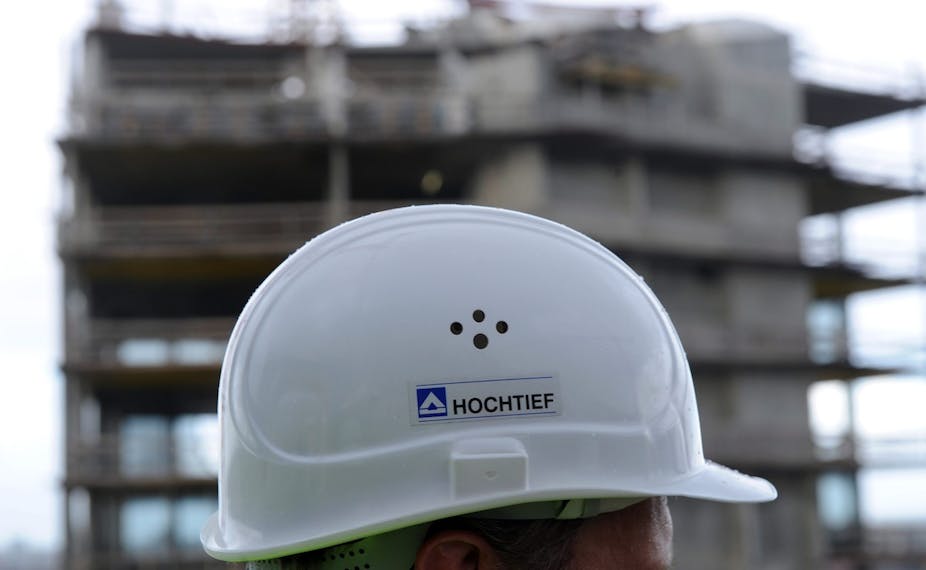With the move by Spanish controlled builder Hochtief/ACS to increase ownership of Leighton Holdings to 74%, management and control of a leading Australian company will go overseas. Already Leighton chief executive Hamish Tyrwhitt and chief financial officer Peter Gregg have confirmed they will step down.
The bid for Leighton may not attract the publicity and attention recently given to other businesses like Qantas, GrainCorp and SPC, but the economic significance is greater.
While construction remains the core activity, Leighton has interests across engineering, infrastructure, mining and resources, telecommunications, property, utilities and environmental services.
Qantas and Leighton share some key characteristics. They are both big direct employers, both have extensive international operations and major overseas shareholders. They also both dominate their local market (65% and around 15% respectively), but vigorously compete with other large firms (Virgin in the air and Lend Lease, Laing O’Rourke and others on the ground).
A less positive shared characteristic is a recent history of losses on major projects in Australia and management missteps in overseas expansion. Dubai-based Habtoor Leighton Group has lost money and market share since Leighton paid A$857 million for a 45% share of the company in 2007. In June 2013 it owed Leighton US$1.1 billion and work in hand halved over the previous 12 months to US$1 billion. There are also ongoing investigations by the Australian Federal Police into allegations of very substantial bribes paid to win pipeline contracts in Iraq.
A giant by any definition
The economic significance of Leighton is easy to miss because the company operates through a large number of subsidiaries, many not sharing the Leighton name. In part this is because it is the result of decades of mergers and takeovers, including Theiss (1983), Visionstream (1996), John Holland (2000) and Henry Walker Eltin (2006). John Holland also acquired Transfield Construction and Walker Constructions in 2002.
Through Nextgen, Leighton owns 30% of Australia’s third largest fibre optic network and its associated data centres, having sold the other 70% in June 2013. Leighton is the world’s largest contract miner, with the majority of its work in Australia, where it is one of three big contractors.
Outside the Middle East, the international operations are managed through the Indian subsidiary Leighton Welspun (60% owned) and Leighton Asia, formed in 2007 by merging Leighton Asia and Leighton International. The Malaysian-based Leighton Offshore provides a comprehensive range of services to the oil and gas industry, particularly offshore developments on the Northwest Shelf.
This giant, sprawling corporate reaches deeply into Australia’s economy and society. For starters, its 28,721 full-time equivalent Australian employees in 2012 was divided almost 50/50 between wage and salary earners, making Leighton (through its companies) the country’s largest employer of graduate engineers and construction project managers. The company’s policy of moving recruits through a number of divisions and a range of projects has developed the expertise required to take on very large complex projects, an important national resource.
However, as a collection of contracting businesses, most of the work done for Leighton Contractors, Theiss and John Holland (nearly A$16 billion of 2011-12 $19 billion in revenue) is actually done by subcontractors. Of that revenue $5 billion was paid to employees and $5 billion to subcontractors, $1.3 billion on plant and over $4 billion for materials. That supports a lot of workers in the trades and supply industries. For example, Leighton subsidiary Visionstream does design, construction and maintenance for communication networks in Australia and New Zealand, and its 1,200 employees are supported by a contractor workforce of over 2,500.
Government projects dominate
What Leighton is best known for is construction of infrastructure and buildings. Leighton is currently building hospitals in Sydney, Adelaide, Perth, Townsville and Hobart, the Northwest and Southwest rail projects in NSW, rail upgrades in Melbourne, Brisbane and Perth, and a multitude of road and other projects around Australia. The company is also a major player in public private partnerships (PPPs) and utilities such as power and water.
This truncated overview of Leighton’s operations is not to suggest that these projects cannot be done without Leighton - its competitors would be happy to take market share from it wherever and whenever they can. It is the case that many of these are significant projects, some of national importance, and Leighton is one of the few Australian companies with the size, the expertise and depth they require.
The fact that much of Leighton’s A$42 billion of work in hand is with Australian governments means this is not a simple takeover. There is a valid community interest in the completion and quality of these projects, and in the value for money received. Some of the PPP projects have contracts that run 20 or 30 years into the future.
Another important point is that under Hochtief as major shareholder Leighton was largely run as an independent Australian company, with a local board and managers who rebuffed Hochtief on a number of occasions. That will clearly not be the case under ACS, which has made it clear it wants a majority on the board and control.
ACS is heavily indebted and is an active asset trader, and credit rating agencies have reacted negatively to the proposed takeover. There are many great assets inside Leighton that could be sold off and some, probably many, will be. How those sales are structured and run should be a matter of public interest. For the remaining minority shareholders the prices gained in such sales and the potential for asset stripping within an international conglomerate like ACS will be an issue.
At this point in time the takeover looks like a great deal for ACS. Whether it will be great for the community, employees, suppliers, clients and other shareholders in Leighton remains to be seen.

